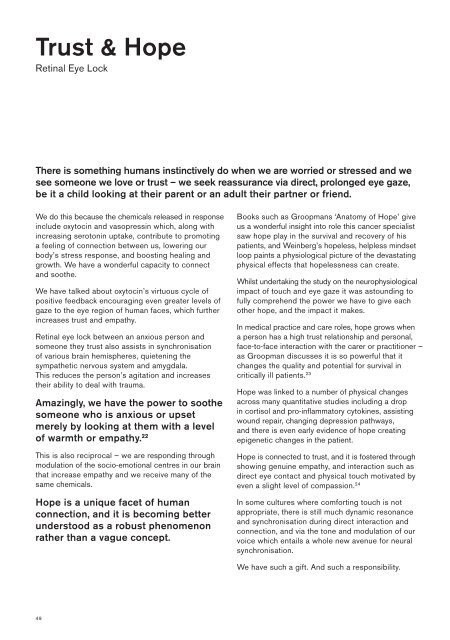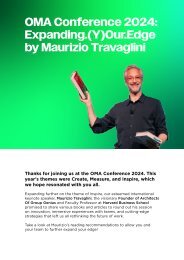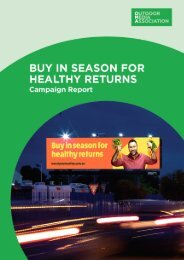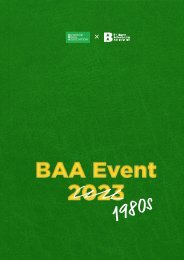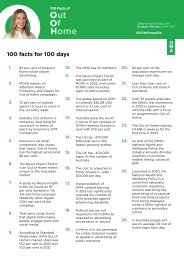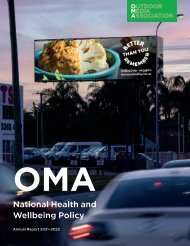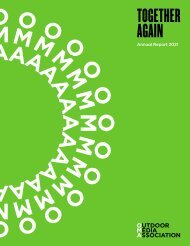THE ART AND SCIENCE OF LOOKING UP REPORT
Create successful ePaper yourself
Turn your PDF publications into a flip-book with our unique Google optimized e-Paper software.
Trust & Hope<br />
Retinal Eye Lock<br />
There is something humans instinctively do when we are worried or stressed and we<br />
see someone we love or trust – we seek reassurance via direct, prolonged eye gaze,<br />
be it a child looking at their parent or an adult their partner or friend.<br />
We do this because the chemicals released in response<br />
include oxytocin and vasopressin which, along with<br />
increasing serotonin uptake, contribute to promoting<br />
a feeling of connection between us, lowering our<br />
body’s stress response, and boosting healing and<br />
growth. We have a wonderful capacity to connect<br />
and soothe.<br />
We have talked about oxytocin’s virtuous cycle of<br />
positive feedback encouraging even greater levels of<br />
gaze to the eye region of human faces, which further<br />
increases trust and empathy.<br />
Retinal eye lock between an anxious person and<br />
someone they trust also assists in synchronisation<br />
of various brain hemispheres, quietening the<br />
sympathetic nervous system and amygdala.<br />
This reduces the person’s agitation and increases<br />
their ability to deal with trauma.<br />
Amazingly, we have the power to soothe<br />
someone who is anxious or upset<br />
merely by looking at them with a level<br />
of warmth or empathy. 22<br />
This is also reciprocal – we are responding through<br />
modulation of the socio-emotional centres in our brain<br />
that increase empathy and we receive many of the<br />
same chemicals.<br />
Hope is a unique facet of human<br />
connection, and it is becoming better<br />
understood as a robust phenomenon<br />
rather than a vague concept.<br />
Books such as Groopmans ‘Anatomy of Hope’ give<br />
us a wonderful insight into role this cancer specialist<br />
saw hope play in the survival and recovery of his<br />
patients, and Weinberg’s hopeless, helpless mindset<br />
loop paints a physiological picture of the devastating<br />
physical effects that hopelessness can create.<br />
Whilst undertaking the study on the neurophysiological<br />
impact of touch and eye gaze it was astounding to<br />
fully comprehend the power we have to give each<br />
other hope, and the impact it makes.<br />
In medical practice and care roles, hope grows when<br />
a person has a high trust relationship and personal,<br />
face-to-face interaction with the carer or practitioner –<br />
as Groopman discusses it is so powerful that it<br />
changes the quality and potential for survival in<br />
critically ill patients. 23<br />
Hope was linked to a number of physical changes<br />
across many quantitative studies including a drop<br />
in cortisol and pro-inflammatory cytokines, assisting<br />
wound repair, changing depression pathways,<br />
and there is even early evidence of hope creating<br />
epigenetic changes in the patient.<br />
Hope is connected to trust, and it is fostered through<br />
showing genuine empathy, and interaction such as<br />
direct eye contact and physical touch motivated by<br />
even a slight level of compassion. 24<br />
In some cultures where comforting touch is not<br />
appropriate, there is still much dynamic resonance<br />
and synchronisation during direct interaction and<br />
connection, and via the tone and modulation of our<br />
voice which entails a whole new avenue for neural<br />
synchronisation.<br />
We have such a gift. And such a responsibility.<br />
Study 3.0<br />
As part of a two year study on the neurophysiology of human touch and eye gaze in regard to therapeutic<br />
relationships and healing, myself and my co-authors reviewed hundreds of quantitative studies on the<br />
interaction between therapist/practitioners and their patients and also with strong, warm relationships<br />
like parents or partners. The study informed this illustrative story of the power of human interaction in<br />
the form of retinal eye lock.<br />
Imagine yourself being admitted to hospital...<br />
As the nurse chats to you and takes your details, the face-to-face interaction has already begun its<br />
electrochemical magic, activating mirror and spindle neurons and the release of various chemicals<br />
discussed above. If they take your hand to take a pulse, an additional synchrony begins as C-fibres in<br />
the skin go through emotional pathways before reaching the brain, further increasing the connection<br />
and assisting the formation of trust. You have your operation and as you see the nurse over the next<br />
few days the trust bond will strengthen with each small interaction.<br />
Then something happens which causes worry or stress, kicking off a negative neurophysiological<br />
process which increases such chemicals as cortisol and adrenalin, dropping oxytocin, dopamine and<br />
serotonin uptake which can then harmfully impact your immune system and impair your ability to deal<br />
with pain and trauma.<br />
Enter the trusted nurse. Five minutes of positive, direct eye gaze, especially if supported by the light,<br />
gentle touch of a hand can turn this around, stimulating the parasympathetic nervous system, altering<br />
hormonal, serotonin and neuroplasticity responses triggered by stress or pain, and boosting immune<br />
system strength for healing and resilience. And the nurse gets a lot of these same chemicals too via<br />
reciprocal feedback loops.<br />
Allowing this precious time to engage directly and empathically helps people feel less vulnerable and<br />
more able to deal with trauma, and incredibly it decreases healing time through such mechanisms<br />
as modulating the interaction of lymphocytes which produce antibodies, and triggering hormone<br />
and neuropeptide changes which mediate emotions. It even impacts morbidity and mortality through<br />
increasing connection and hope. 25<br />
49<br />
50


